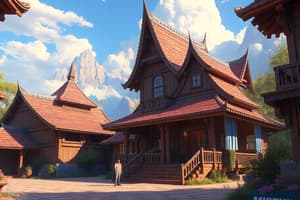Podcast
Questions and Answers
What type of shot composition uses the camera as the eyes of the talent?
What type of shot composition uses the camera as the eyes of the talent?
- Eye Level
- Low Angle
- High Angle
- Subjective (correct)
In shot composition, what does a High Angle shot do to the object photographed?
In shot composition, what does a High Angle shot do to the object photographed?
- Brings out intricate details
- Makes it seem smaller and less significant (correct)
- Enhances its power
- Makes it appear larger and more significant
Which shot composition angle provides a sense of powerlessness within a scene?
Which shot composition angle provides a sense of powerlessness within a scene?
- Subjective
- Eye Level
- Low Angle (correct)
- High Angle
What does Eye Level shot composition aim to portray?
What does Eye Level shot composition aim to portray?
Which shot composition angle involves elevating the camera above the action using a crane?
Which shot composition angle involves elevating the camera above the action using a crane?
What is the purpose of Shot Composition Background according to the text?
What is the purpose of Shot Composition Background according to the text?
Why should Natural Cut Off Lines be avoided in shot composition?
Why should Natural Cut Off Lines be avoided in shot composition?
What does Shot Composition Depth aim to achieve?
What does Shot Composition Depth aim to achieve?
How is the Rule of Thirds applied in Shot Composition?
How is the Rule of Thirds applied in Shot Composition?
What is the purpose of Shot Composition Leadroom?
What is the purpose of Shot Composition Leadroom?
What does Headroom refer to in shot composition?
What does Headroom refer to in shot composition?
Flashcards are hidden until you start studying
Study Notes
Shot Composition Techniques
- A Point of View (POV) shot uses the camera as the eyes of the talent, allowing viewers to see the scene from the character's perspective.
- A High Angle shot looks down on the subject, creating a sense of vulnerability or insignificance for the object photographed.
- Low Angle shots make the subject appear powerful and imposing, giving a sense of powerlessness to other elements in the scene.
Eye Level and Camera Elevation
- Eye Level shots aim to portray a neutral perspective, maintaining an authentic view that aligns with how humans naturally perceive the world.
- An Aerial shot involves elevating the camera above the action using a crane, providing a broad view and enhancing context.
Composition Principles
- The Shot Composition Background serves to enhance the main subject, providing context and setting while avoiding distractions.
- Natural Cut Off Lines should be avoided to prevent cutting off subjects in unflattering ways, ensuring a cleaner and more aesthetically pleasing composition.
Creating Depth and Structure
- Shot Composition Depth aims to create a sense of three-dimensionality, making scenes feel more immersive and inviting.
- The Rule of Thirds divides the frame into a grid of nine equal parts, guiding the placement of subjects along these lines or intersections for a balanced composition.
Effective Framing Techniques
- Leadroom refers to the space in front of a moving subject, important for implying motion and directing viewer focus.
- Headroom indicates the space above a subject's head within the frame, crucial for achieving a balanced visual effect and preventing a cramped appearance.
Studying That Suits You
Use AI to generate personalized quizzes and flashcards to suit your learning preferences.




